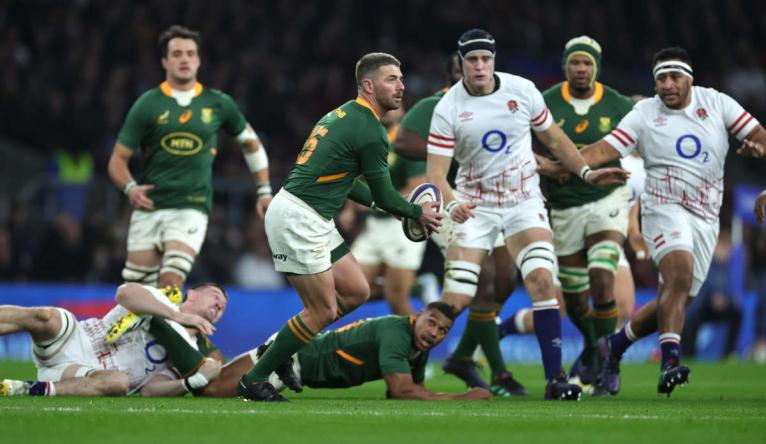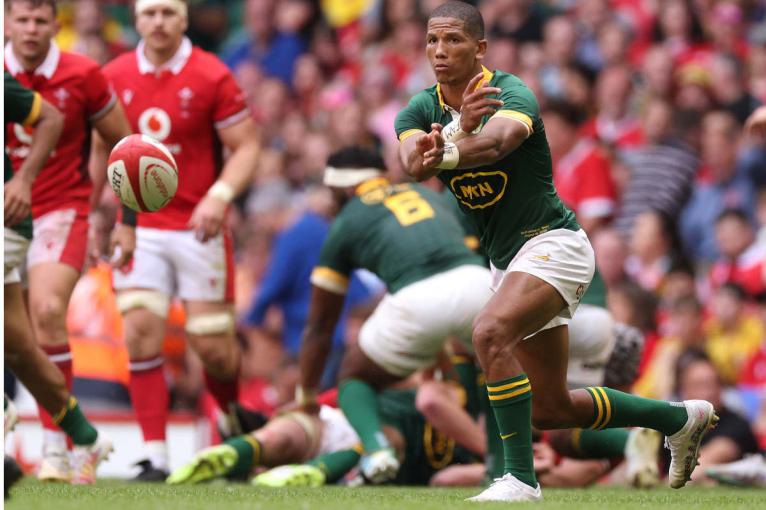Since 1995, and perhaps long before that, the Springboks have built their identity around the simple metric of winning. The ends would justify the means. Entertainment would be found at the victory parade. Even grandiose ambitions such as nation building and fostering a sense of unity in a fractured land would follow in the wake of triumphs. As Rassie Erasmus said during the World Cup run in 2019, “Keep the main thing the main thing.”
This means that pragmatism has trumped panache. Experimentation has always fitted within tight parameters. And as the years went on, the notion that the Springboks played in a certain structured way calcified and became an accepted truth around the world.
But something happened on Friday night under the lights of Twickenham. It wasn’t recorded on the scoreboard, but that’s exactly why it was the most significant moment in the Springboks 35-7 win over the All Blacks. Not because it resulted in anything tangible, but because of how it made us feel.
Five minutes into the second half, with the Springboks already in the ascendancy thanks to their trademark grunt from the pack, the ball went loose at the back of a ruck on New Zealand’s side. Canan Moodie, a 20-year-old playing his first ever Test in the midfield, flicked one of his lanky legs and knocked the pill out of Rieko Ioane’s hands.

Moodie then picked it up on the trot, accelerated down field, stepped Beauden Barrett as if he wasn’t an all-time great, did the same to Richie Mo’unga and dotted down for one of the most spectacular solo-tries ever recorded by a kid not old enough to order liquor in the United States.
Except, it wouldn’t count. It was chalked off because Moodie was adjudged to have been off-side in the build up. The try was struck from the record. Indeed, it didn’t even feature in Sky Sport’s official highlights package on YouTube.
And yet that was the most talked-about incident in the post-match press room. Seasoned journalists and broadcasters were practically swooning. No doubt the conversations in South-West London and back in South Africa were similarly zeroed in on Moodie’s magic.
The Lions of Johannesburg marched to three consecutive Super Rugby finals playing a brand of rugby that rivalled anything served up from New Zealand at the time
The angst and chest-thumping around the 7-1 split on the bench, the rolling maul tactic and the way referee Matt Carley called the game would come later. In the immediate afterglow of the Springboks’ biggest ever win over the fiercest rival, a non-event was the headline act.
This is part of a broader evolution in South African rugby. Of course dazzling hot-steppers who play no-look passes on the inside as decoy runners whizz around them are nothing new. The Lions of Johannesburg marched to three consecutive Super Rugby finals playing a brand of rugby that rivalled anything served up from New Zealand at the time. Allister Coetzee’s Stormers were also razzamatazz merchants. But both sides failed to win anything of great value, underlining previous assumptions and firm beliefs.

And so the likes of Bryan Habana, JP Pietersen, Breyton Paulse and Pieter Rossouw were asked to adhere to the right angles of a structured game plan. If they saw a half gap, they had the right to glide through it. If there was the chance of an intercept they were encouraged to take it. But over time, any player with flair would either mould themselves to fit ‘The Springboks’ Way’ or they’d be cast aside as a luxury item. Brent Russell is the most famous example of this, though there are others.
Jacques Nienaber has confessed that his team’s evolution has been intentional. That the attacking instincts of Willemse, Moodie, Kolbe, le Roux and Manie Libbok at 10, have been a part of his plan since he took over from Erasmus
Cheslin Kolbe helped shift the paradigm but it was Willie le Roux’s presence that was the catalyst for change. Not since Andre Joubert had the Springboks been able to field a full-back who read space as clearly and quickly as le Roux. He has his faults, and he cops criticism more than any of his teammates. Sure, he doesn’t have the best kicking game and he’s hardly a physical force, but whenever he joins the line or pulls another player into position, the Springboks break free from their shackles and start to paint pictures that were once only found elsewhere.
Jacques Nienaber has confessed that his team’s evolution has been intentional. That the attacking instincts of Willemse, Moodie, Kolbe, le Roux and Manie Libbok at 10, as well as the injured Lukhanyo Am at 13, have been a part of his plan since he took over from Erasmus after the last World Cup.
But the Covid pandemic ground his operation to a halt. When the Springboks emerged after a year hiatus to take on the British & Irish Lions, pragmatism once again crushed the desire to entertain. Winning was all that mattered and the Springboks went back to what they knew would work and slogged out a 2-1 Series victory.

With the Lions tamed, Nienaber could tweak a few working parts here and there. He’s been blessed with the personnel to do so, but he’s also emboldened Le Roux to step up at first receiver and dictate play with front foot ball. He’s shown faith in Libbok despite questions around his goal kicking. He’s blooded jet-heeled wingers and has been blessed with a Kolbe clone in the form of Kurt-Lee Arendse. The more robust runners in Damian de Allende, Makazole Mapimpi and Andre Esterhuizen still play important roles as battering rams and defensive blocks. Except now they are part of a multi-faceted arsenal that can hurt teams in multiple ways.
And whatever happens over the next two months, regardless if the Springboks defend their title, that fact will resonate with Springboks fans who have long cast envious eyes in the direction of New Zealand, Australia, France and Scotland and wondered why, with all their resources and talent, their side couldn’t cut the opposition to ribbons and score tries plucked from a PlayStation game. Sure, winning felt good. But wouldn’t it be lekka if they won and compelled us to lift our bums off seats? We no longer have to wonder.



The Boks are known for their dominant forwards, but we haven't always been able to sync an awesome pack with an electric backline. It seems that is now coming together. The backs have perfected the rush defence which rattled the AB's like never before! Ironically the AB's are the masters at intensity, but the Boks have learnt to match that intensity from the beginning. Ireland and France and pretty good at it too!
I predict that, regardless the outcome of the WC, this bok team under Nienaber will be remembered for this exciting backline.
Looking forward to some of the young prospects that will no doubt come through like Moodie has. Particularly from the Stormers. There’s something in the water down there!
Alistair's Stormer's had no razzamatazz. They where known as a Stormers side who looked more confident without the ball. Great defence because of JNs influence.
Pieter Rossouw together with Percy under Nick Mallet ripped the French and Scotts to pieces.
Kiwis making silk purses from a sows ear in these comments. so funny.
There's a reason Moodie's try didn't feature in Sky's coverage. It wasn't a try. Wax on all you like. But the guy was two metres offside, not bound. Had he been behind the last feet he wouldn't have pressured Ioane, wouldn't have picked up the ball, wouldn't have beaten Barrett, nor Mounga and he wouldn't have scored. Which he didn't. Why not talk about Jordan's brilliance in getting his 24th try in 24 tests? Why? Because he didn't score. Because there was a knock on earlier. Wax on all you like but the 'brilliance' only happened because he was offside.
Great piece to read.
Moodie looks a sensational prospect for sure. What club does he play for?
Finally, an interesting analysis of the GLOBAL evolution of what can be the long-term evolution of a team's style of play.
What the Boks do is exactly what Galthié does with France! The only (significant) difference is the starting point.
Another comment- I am not fixated in the win at all approach and am not too phased if we don’t win the WC. What I do want is us to continue to develop so the ABs and other sides don’t know how we are going to play. The day we get the mix right between our forward’s genetics and the developing backline skills will make us a bloody difficult opponent.
Really good to read these comments. The ‘real’ change to our side is not all the tight forwards, or 7/1 bench or all the other noise, but the gradual and continual shift towards highly skilled steppers and creative backs, started by Am and carried on to Moodie. Our franchises in the URC are also playing this ball in hand heads up approach( witness Lions and Stormers) which we never really got right in Super rugger. The month long trudge to Australasia playing on those wet fields with local refs never allowed us space to develop these type of players. I am hopeful as we continue to expand our reach in URC and hopefully get more teams playing in these leagues, as well as the noticeable trickle of overseas guys coming back to our shores to beef up our local sides. Hopefully these trends continue.